Ticket to Ride New York review: one of the best cheap board games available
Ticket to Ride: New York is easy to learn, plays in 20 minutes, and yet packs in enough interesting choices to feel like a full game experience
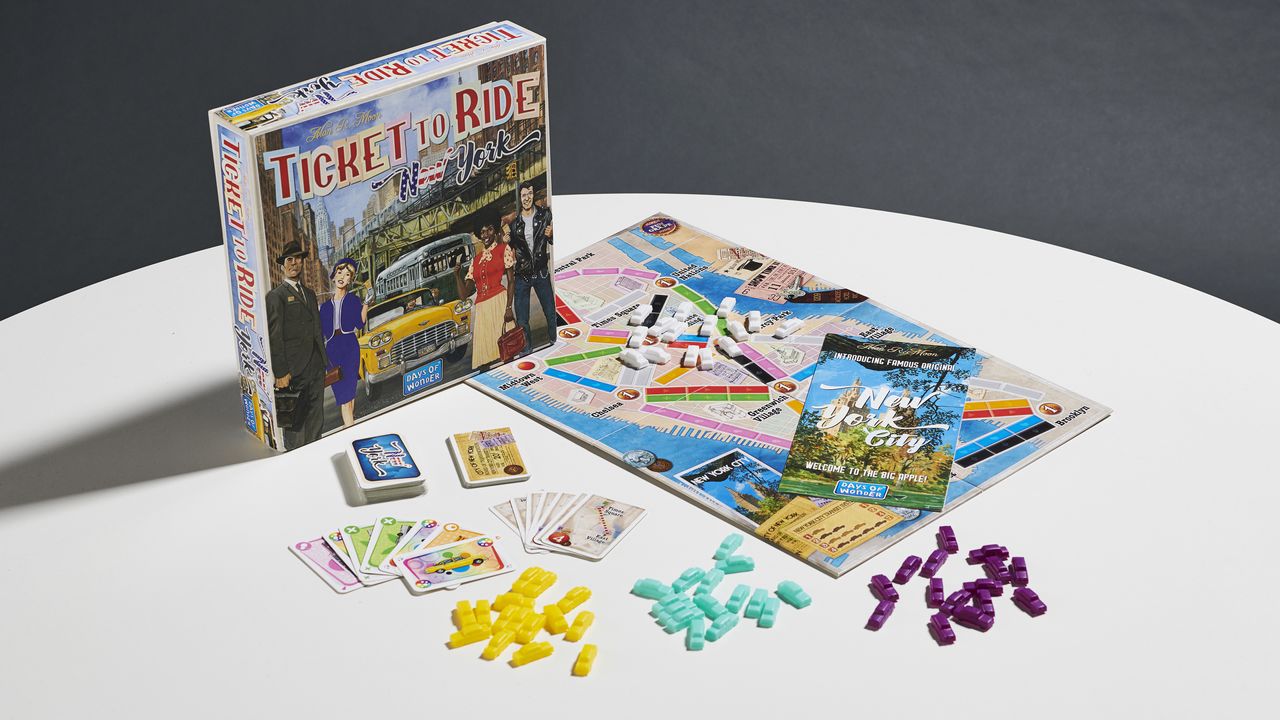
Ticket to Ride New York is fast-paced and fun, and rather than feeling like a cut-down version of the original game, it's like a concentrated version. It's easy to learn, and is excellent value.
-
+
Fast to play
-
+
Plenty of strategy
-
+
Great with 2, 3 or 4
-
+
Low price
-
-
Can finish suddenly
-
-
Long-term variety is limited
Why you can trust T3

Ticket to Ride New York is a shorter and sharper version of one of the most popular board games in the world. The original Ticket to Ride has been around for nearly two decades, and has spawned a huge number of variant versions that add new mechanics and mix it up in interesting ways for fans of the series… in fact, we have a whole 'Which version of Ticket to Ride you buy' guide.
But Ticket to Ride New York doesn't add anything. In fact, it takes things away. It's a smaller version of the game, a shorter version, and a much cheaper version. And yet it does it while really keeping the spirit of the game intact, which is why it gets the top spot in our list of the best cheap board games – and holds a high place in our list of the best board games overall.
If you want to dabble into board games with inexpensive and quick games that really give you a taste of what bigger games can be, it's ideal. Or it's the perfect little family game, or makes a seriously good gift.
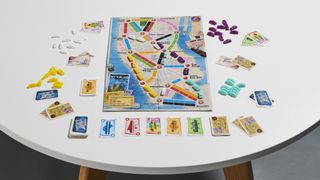
Ticket to Ride New York: Price and who it's for
You will find Ticket to Ride New York for under £20/$20, with the exact price varying by retailer. As I've mentioned, the price is a big part of why this is such a compelling buy, but it's not just that the cost is low – it's a really nicely made package, which makes it feel like excellent value, rather than something from the bargain bin.
Ticket to Ride New York is a pretty classic family game, in the sense that it's happily playable by kids of eight and up (officially – younger kids may be able to pick it up) as well as adults, and everyone gets just as much fun out of it.
Its short length might be a big advantage with some kids, because it plays in 20 minutes (not including time to teach on your first play), so if you need to fill some time you can play a few rounds and keep track of who won each time – but if kids want to do something else after a while, you're not stuck in the middle of a long game when they get restless.
As for adults, the game can get surprisingly competitive when you know how it works, though it certainly doesn't ever have to feel mean. If you've got a bit of time to kill with 2-4 people, you can play as many games of it as fit into that time, and they don't feel too repetitive.
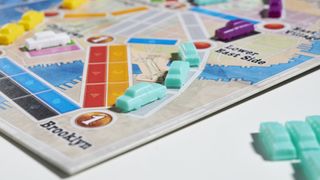
Ticket to Ride New York: How it plays
Ticket to Ride New York follows the basic Ticket to Ride formula that the games have used since the launch of the original: you need to claim routes across a board as your own, so that you can earn the points you need to win.
In this game's case, the board is a little recreation of New York, and you all have a pool of plastic taxi pieces. The board is filled with famous New York locations, and these are linked to each other by coloured lines.
Next to the board is a deck of cards with different colours on them, with a 'marketplace' of five face up cards visible to everyone at the table. You'll each have a hand made up of these cards, and these are basically the resources you can use to build your routes.
On your turn, you can do one of three things: draw coloured cards into your hand from the options on the table; or use the cards in your hand to claim a route between two locations and place your taxis on the board; or you can draw new 'Destination' cards, which can help you really boost your points.
If you want to claim a route on the board, you need to have the right number of matching-colour cards in your hand – so a route with three red lines requires three red cards. If you claim a route and place your taxis there, that's it – the route is yours, and no one else can push you from it. In some cases, there are two different colours between locations, meaning two people can go there. In some cases, there isn't – if you miss out, then tough.

How do you choose which routes to claim? That's where the 'Destination' cards come in – at the start of the game, everyone receives at least one Destination card, which shows two locations on the board. If you create a continuous path of your taxes between those two locations, you get the number of points on the card. If you fail, you lose that many points. Destination cards will absolutely make or break your game.
The fun about the Destination cards is that they offer a risk vs reward temptation. You'll get to choose which Destination cards you want to keep, and the further away the locations on the card are, the more points they give… but it'll be much harder to achieve.
As mentioned, you can draw more Destination cards during the game, which can be vital to winning – the best case scenario is that you draw a card depiction two locations you happen to have already linked with your taxis, meaning free points. The worst case scenario is that you get a card with a really long route that's literally impossible to finish because other people took all the connecting routes already.
You also get points literally every time you claim a route (but routes that require more cards provide more points), and there are 'tourist' locations on the board that give you points for linking them no matter whether they're on your Destination card or not. I mentioned that Destination cards make or break your game, but they don't necessarily make you the winner – all these other point sources really add up to determine who's number one.
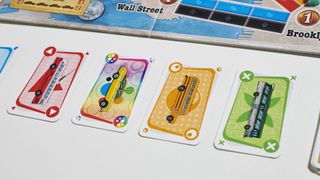
It means there are lots of ways to score points, which is where kids might struggle to work out the best strategies, but it's never hard or confusing to play, because you can only do one thing per turn, and what you need to do often feels pretty clear and easy: if you have enough cards, claim a route; if don't have enough cards, pick up cards; if you've completed your Destination cards, pick up new ones. Easy.
The only thing that can ever feel frustrating or limiting in Ticket to Ride New York is the end, because it can really sneak up on you before you've finished your careful plans. The game ends when someone has used up all but two of their taxi pieces, and it's very easy not to notice that this is likely to happen imminently – you might be two turns away from completing a tough Destination card, and someone just ends the game before you can…
But then, the game was only 20 minutes long! If you feel hard done by, it's easy to just say "Another round!" and get that satisfying feeling next time.
In terms of replayability, the Destination cards are key to making it possible to play a few times in a row without it feeling repetitive, because every set of cards gives you a different puzzle to solve on the board. What's the most efficient route, and how quickly can you get the coloured cards you need to make it happen? What if someone else takes the vital route you need – what's plan B?
However, you might find that there's not enough variation here if you don't have many board games, and you play it over and over really regularly. It's best as part of a collection with just a few other great-value and different styles of game, so that the amount of variation it's able to offer doesn't wear thin.
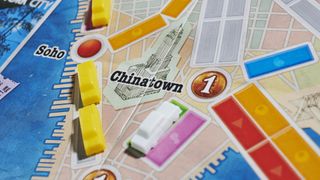
Ticket to Ride New York: Verdict
I love Ticket to Ride New York, and it's one of the most-played games in my collection, because it's so easy to just break out between larger games as a palate cleanser, or at the end of a day as a fun way to wind down.
But I 100% recommend it for people who don't play it that way – who just want a fun game that's more of a main game for them, because while it's a fast and easy game, it's not slight – there's plenty of strategy to execute, and so it's satisfying when you when. It feels like it's using brainpower – it's just not a taxing about of brainpower.
As mentioned, I think if you play it over and over, every week, you might find that it lacks variety, but in all other cases, it's fantastic value for money.
Ticket to Ride New York: Also consider
Obviously, the other, larger, Ticket to Ride games are an option – if you like the sound of this, but would prefer a version that lasts an hour or so, and that let's you expand the simple strategies here into longer versions of the same with more to juggle, then see our big Ticket to Ride guide.
However, if you want something that's more compact (like Ticket to Ride New York), only a little more complicate to play, but that offers lots more strategic options and lasts around 40 minutes, then read our Splendor review. It's a very smart game of using gems to buy mines that create more gems, which let you buy better mines – an upward spiral of smart collecting, where you're racing to be the first to a set number of points. It's great, and comes with lovely poker chips.
Ticket to Ride New York is great with two players, but for a dedicated two-player game at a similar level of complexity (but that's even more craftily designed), check out our Jaipur review. It's also about claiming valuable things before your opponent can, and also takes about 20 minutes per round, but it's even smaller and even cheaper.
Sign up to the T3 newsletter for smarter living straight to your inbox
Get all the latest news, reviews, deals and buying guides on gorgeous tech, home and active products from the T3 experts
Matt is T3's former AV and Smart Home Editor (UK), master of all things audiovisual, overseeing our TV, speakers and headphones coverage. He also covered smart home products and large appliances, as well as our toys and games articles. He's can explain both what Dolby Vision IQ is and why the Lego you're building doesn't fit together the way the instructions say, so is truly invaluable. Matt has worked for tech publications for over 10 years, in print and online, including running T3's print magazine and launching its most recent redesign. He's also contributed to a huge number of tech and gaming titles over the years. Say hello if you see him roaming the halls at CES, IFA or Toy Fair. Matt now works for our sister title TechRadar.
-
 The UK gets a huge free streaming service that kicks off a new era for TV
The UK gets a huge free streaming service that kicks off a new era for TVChannel 5 and My5 merge to create something bigger and more exciting
By Rik Henderson Published
-
 You can watch Disney+'s 96%-rated sci-fi show for free, with one hitch
You can watch Disney+'s 96%-rated sci-fi show for free, with one hitchAndor is on YouTube!?
By Max Freeman-Mills Published
-
 Philips Hue could be launching its first-ever video doorbell – here's what we know so far
Philips Hue could be launching its first-ever video doorbell – here's what we know so farIt's a logical next step
By Lizzie Wilmot Published
